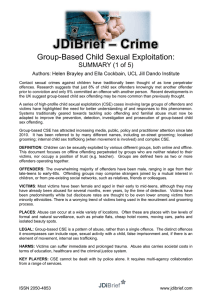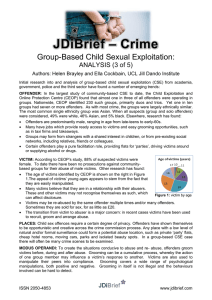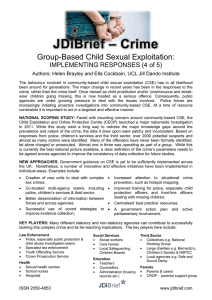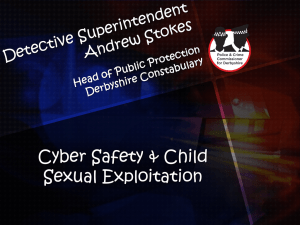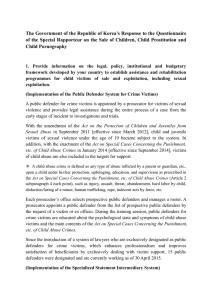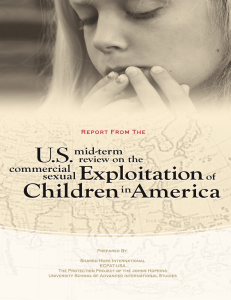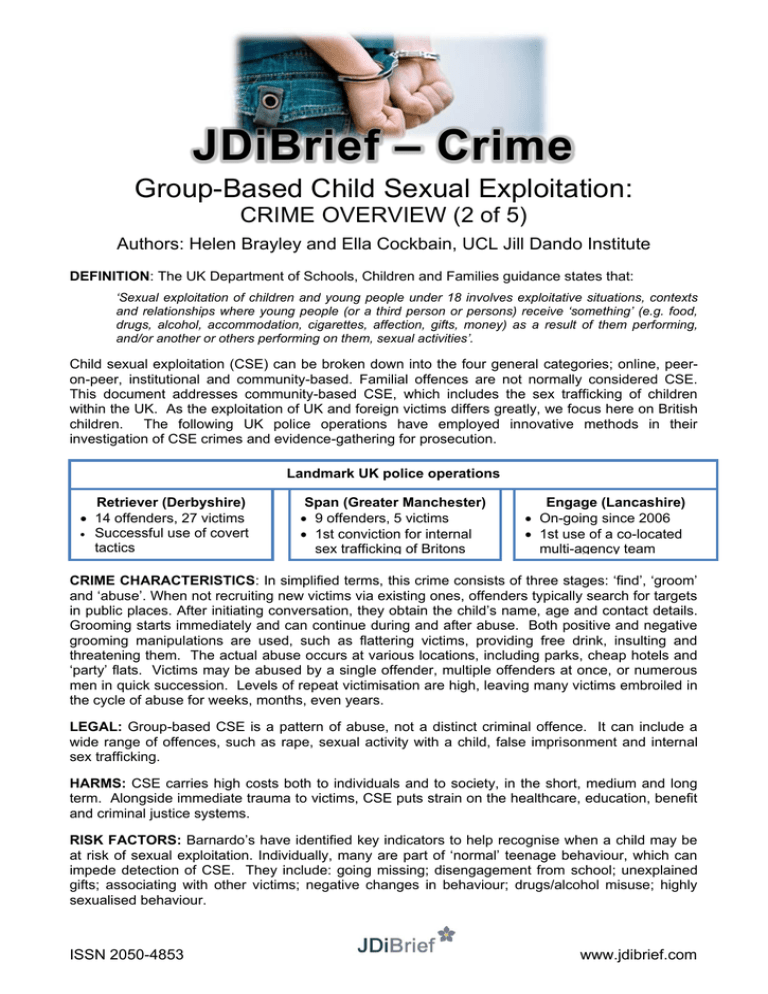
JDiBrief – Crime
Group-Based Child Sexual Exploitation:
CRIME OVERVIEW (2 of 5)
Authors: Helen Brayley and Ella Cockbain, UCL Jill Dando Institute
DEFINITION: The UK Department of Schools, Children and Families guidance states that:
‘Sexual exploitation of children and young people under 18 involves exploitative situations, contexts
and relationships where young people (or a third person or persons) receive ‘something’ (e.g. food,
drugs, alcohol, accommodation, cigarettes, affection, gifts, money) as a result of them performing,
and/or another or others performing on them, sexual activities’.
Child sexual exploitation (CSE) can be broken down into the four general categories; online, peeron-peer, institutional and community-based. Familial offences are not normally considered CSE.
This document addresses community-based CSE, which includes the sex trafficking of children
within the UK. As the exploitation of UK and foreign victims differs greatly, we focus here on British
children. The following UK police operations have employed innovative methods in their
investigation of CSE crimes and evidence-gathering for prosecution.
Landmark UK police operations
Retriever (Derbyshire)
14 offenders, 27 victims
Successful use of covert
tactics
Span (Greater Manchester)
9 offenders, 5 victims
1st conviction for internal
sex trafficking of Britons
Engage (Lancashire)
On-going since 2006
1st use of a co-located
multi-agency team
CRIME CHARACTERISTICS: In simplified terms, this crime consists of three stages: ‘find’, ‘groom’
and ‘abuse’. When not recruiting new victims via existing ones, offenders typically search for targets
in public places. After initiating conversation, they obtain the child’s name, age and contact details.
Grooming starts immediately and can continue during and after abuse. Both positive and negative
grooming manipulations are used, such as flattering victims, providing free drink, insulting and
threatening them. The actual abuse occurs at various locations, including parks, cheap hotels and
‘party’ flats. Victims may be abused by a single offender, multiple offenders at once, or numerous
men in quick succession. Levels of repeat victimisation are high, leaving many victims embroiled in
the cycle of abuse for weeks, months, even years.
LEGAL: Group-based CSE is a pattern of abuse, not a distinct criminal offence. It can include a
wide range of offences, such as rape, sexual activity with a child, false imprisonment and internal
sex trafficking.
HARMS: CSE carries high costs both to individuals and to society, in the short, medium and long
term. Alongside immediate trauma to victims, CSE puts strain on the healthcare, education, benefit
and criminal justice systems.
RISK FACTORS: Barnardo’s have identified key indicators to help recognise when a child may be
at risk of sexual exploitation. Individually, many are part of ‘normal’ teenage behaviour, which can
impede detection of CSE. They include: going missing; disengagement from school; unexplained
gifts; associating with other victims; negative changes in behaviour; drugs/alcohol misuse; highly
sexualised behaviour.
ISSN 2050-4853
www.jdibrief.com

